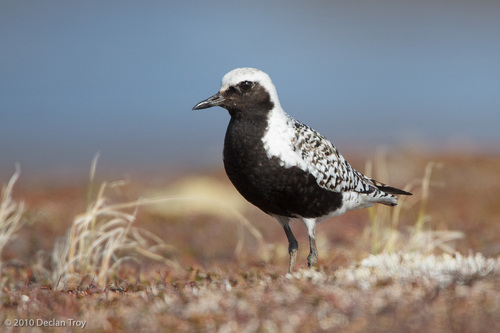
Black-bellied Plover
The Black-bellied Plover (*Pluvialis squatarola*) is a striking shorebird known for its distinctive black belly and white rump during the breeding season. It is a highly migratory species, undertaking impressive long-distance journeys between its Arctic breeding grounds and coastal wintering areas across the globe. Ecologically, it plays a role in controlling populations of invertebrates in both its breeding and non-breeding habitats. While not holding specific cultural significance in many areas, it is a highly appreciated bird among birdwatchers for its beauty and widespread distribution.
27-30 cm
Length
71-83 cm
Wingspan
Least Concern
Conservation Status
Distribution
Breeds in the high Arctic tundra across North America, Europe, and Asia. Migrates to coastal areas worldwide, including North and South America, Europe, Africa, Asia, and Australia. Altitudinal range is generally from sea level to around 100 meters, though they can be found at higher elevations during migration.
Lifespan
Up to 21 years recorded in the wild, though the average lifespan is likely shorter.
Black-bellied Plover's Habitat
Habitat Types
Coastal mudflats, Sandy beaches, Estuaries, Salt marshes, Tundra (breeding)
Climate Zones
Arctic (breeding), Temperate, Tropical, Subtropical
Adaptations
Their relatively long legs and bills are well-suited for foraging in shallow water and mud. They also possess excellent eyesight for spotting prey.
Variations
Three subspecies are generally recognized, differing slightly in size and plumage darkness: *P. s. squatarola*, *P. s. tomkovichi*, and *P. s. cynosurae*. These variations are subtle and often require expert observation to distinguish.
Appearance
Breeding Plumage
Breeding plumage features a stark black belly, face, and throat, contrasting with a white crown, nape, and rump. Non-breeding plumage is much duller, with a mottled gray-brown back and a whitish belly.
Seasonal Feather Changes
The transition between breeding and non-breeding plumage occurs through molting, typically starting in late summer after breeding and completing before the spring migration.
Sex Based Plumage Differences
Males generally have more intensely black underparts during breeding season, but differences are subtle.
Notable Features
Black axillaries (underwing feathers) are visible in flight, a key identification feature., White rump and wing stripe are prominent in flight., Relatively thick, black bill.
Diet and Feeding
Primary Foods
Marine worms, Crustaceans, Mollusks, Insects, Small fish (occasionally)
Foraging Behavior
Primarily visual foragers, they run and pause, scanning the ground for prey. They often probe the mud or sand with their bills to extract invertebrates.
Specializations
Their bill and leg length are adapted for foraging in a variety of intertidal habitats.
Seasonal Diet Variations
Diet shifts with prey availability. During the breeding season on the tundra, insects are a major food source. On the wintering grounds, marine invertebrates dominate.
Behavior
Social Structure
Generally solitary or in small flocks during the non-breeding season. Can form larger flocks during migration and at particularly rich feeding sites. Territorial during the breeding season.
Communication
A plaintive, three-note whistle ('too-lee-oo') is a common call., Various other calls are used during courtship and territorial defense.
Migration
Long-distance migrants. Some individuals travel over 10,000 km between breeding and wintering grounds. They often fly non-stop for long distances, utilizing favorable winds.
Territorial or Group Behaviors
Males defend breeding territories against other males. Outside of the breeding season, they are generally not territorial, though they may defend small feeding areas.
Conservation
Threats
Habitat loss and degradation (coastal development, pollution), Climate change (sea-level rise, changes in tundra ecosystems), Disturbance at stopover sites during migration, Hunting (in some regions)
Protection Programs
Migratory Bird Treaty Act (US and Canada), African-Eurasian Waterbird Agreement (AEWA), Various national and international conservation efforts focused on shorebird habitat protection.
Local National Laws
Protected under various national wildlife laws in many countries across its range.
Population Trend
Decreasing
Population Estimates
Global population estimated to be around 400,000 individuals.
Interesting Facts
They are known for their remarkable migratory endurance.
Some populations fly non-stop for thousands of kilometers over the ocean.
Their black axillaries (underwing feathers) are a key identification feature.
This distinguishes them from other similar plover species, especially in flight.
They are one of the largest plover species.
This makes them relatively easy to spot on mudflats and beaches.
Faqs about Black-bellied Plover
What is the difference between a Black-bellied Plover and a Golden Plover?
Black-bellied Plovers have black axillaries (underwing feathers) and a white rump, while Golden Plovers have golden or yellowish plumage and lack the black axillaries.
Where can I see a Black-bellied Plover?
They are commonly seen on coastal mudflats, beaches, and estuaries during migration and in the winter. Look for them in areas with exposed mud or sand where they can forage for invertebrates.
Are Black-bellied Plovers endangered?
No, they are currently classified as Least Concern by the IUCN, although their population is declining.
Copyright @ Nature Style Limited. All Rights Reserved.
 English
English